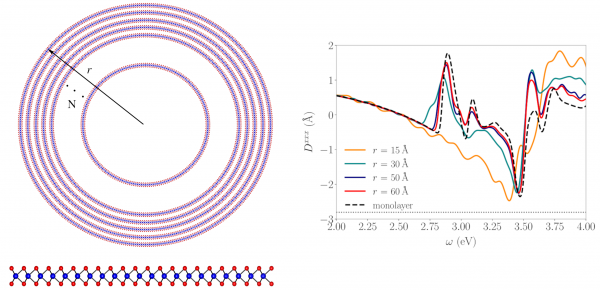Understanding the large shift photocurrent of WS2 nanotubes: A comparative analysis with monolayers
The bulk photovoltaic effect generates a dc current in acentric materials upon light absorption. Transition metal dichalcogenide nanotubes offer an ideal platform to study the effect, given the large light-absorption capabilities of the constituent materials in two-dimensions. This study analyzes the shift-current contribution to the bulk photovoltaic effect in WS2 nanotubes using ab-initio calculations, and places the theoretical results in the context of recent experimental measurements.
Current solar-cells are based on the standard photovoltaic effect and employ so-called pn-junctions, namely interfaces between two different semiconductors that generate a built-in electric field that drives the photoexcited electrons. Interestingly, crystals that lack an inversion center in their crystalline structure exhibit a distinctive effect, namely the bulk photovoltaic effect. In contrast to the standard effect in pn-junctions, the bulk photovoltaic effect is quadratic in the electric field of light and occurs in homogeneous crystals; therefore it needs no interfacing technique to be employed as a solar cell. In simple terms, this effect converts light into electricity intrinsically. Its implementation would open the door to solar-cells potentially exceeding current technologies, which can play an important role in coming years.
In this study, the researchers investigated a central contribution to the bulk photovoltaic effect, namely the shift photocurrent, in transition-metal dichalcogenide monolayers and nanotubes. The analysis is based on density functional theory in combination with the Wannier interpolation technique, and the results show that for a nanotube radii of practical interest r>60 Å, the shift photoconductivity of a single-wall nanotube is well described by that of the monolayer. Additionally, the research team has quantified the shift photocurrent generated under realistic experimental conditions like device geometry and absorption capabilities, showing that a typical nanotube can generate a photocurrent of around 10 nA, while the monolayer only attains a maximum of 1 nA. This enhancement is mainly due to the larger conducting cross section of a nanotube in comparison to a monolayer.
These findings suggest that the large nonlinear photocurrent measured recently in WS2 nanotubes [Zhang et al., Nature (London) 570, 349 (2019)] originates from the shift mechanism, making nanotubes a promising platform for solar energy extraction via the bulk photovoltaic effect.

Figure: On the left, a multiwall zigzag nanotube of radius r composed of N layers and a two-dimensional hexagonal monolayer. On the right, the calculated shift distance tensor component xxx as a function of photon frequency for single-wall nanotubes with varying radii (r) and a monolayer. The nanotube result is seen to converge to the monolayer limit above r>60 Å. The grey dashed line shows the average bond length of 2.8 Å between the ions in the monolayer.



